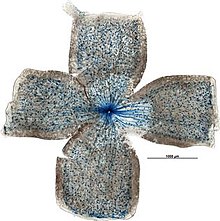Melanopsin
| OPN4 | |||
|---|---|---|---|
| Identifiers | |||
Gene ontology | |||
| Molecular function | |||
| Cellular component | |||
| Biological process |
| ||
| Sources:Amigo / QuickGO | |||
Ensembl | |||||||||
|---|---|---|---|---|---|---|---|---|---|
| UniProt | |||||||||
| RefSeq (mRNA) | |||||||||
| RefSeq (protein) | |||||||||
| Location (UCSC) | Chr 10: 86.65 – 86.67 Mb | Chr 14: 34.31 – 34.32 Mb | |||||||
| PubMed search | [3] | [4] | |||||||
| View/Edit Human | View/Edit Mouse |
Melanopsin is a type of
photoreceptor cells, respectively.In humans, melanopsin is found in
Discovery

Melanopsin was discovered by
These retinal ganglion cells were found to be innately photosensitive, since they responded to light even while isolated, and were thus named
Species distribution
Mammals have
Structure
The human melanopsin gene, opn4, is expressed in
Melanopsin, like all other animal
Melanopsin is more closely related to
Function
Melanopsin-containing ganglion cells,
Evidence for melanopsin's physiological light detection has been tested in mice. A mouse cell line that is not normally photosensitive,
Melanopsin photoreceptors are sensitive to a range of wavelengths and reach peak light absorption at blue light wavelengths around 480 nanometers.[37] Other wavelengths of light activate the melanopsin signaling system with decreasing efficiency as they move away from the optimum 480 nm. For example, shorter wavelengths around 445 nm (closer to violet in the visible spectrum) are half as effective for melanopsin photoreceptor stimulation as light at 480 nm.[37]
Melanopsin in the iris of some, primarily nocturnal, mammals closes the iris when it is exposed to light. This local pupil light reflex (PLR) is absent from primates, even though their irises express melanopsin.[7]
Mechanism
When light with an appropriate frequency enters the eye, it activates the melanopsin contained in
Melanopsin-containing ganglion cells are thought to influence these targets by releasing the
Effects on circadian rhythm
Melanopsin serves an important role in the photoentrainment of circadian rhythms in mammals. An organism that is photoentrained has aligned its activity to an approximately 24-hour cycle, the solar cycle on Earth.[43] In mammals, melanopsin expressing axons target the suprachiasmatic nucleus (SCN) through the retinohypothalamic tract (RHT).[9]
In mammals, the eye is the main photosensitive organ for the transmission of light signals to the brain. However, blind humans are still able to entrain to the environmental light-dark cycle, despite having no conscious perception of the light. One study exposed subjects to bright light for a prolonged duration of time and measured their melatonin concentrations. Melatonin was not only suppressed in visually unimpaired humans, but also in blind participants, suggesting that the photic pathway used by the circadian system is functionally intact despite blindness.[44] Therefore, physicians no longer practice enucleation of blind patients, or removal of the eyes at birth, since the eyes play a critical role in the photoentrainment of the circadian pacemaker.
In mutant breeds of mice that lacked only rods, only cones, or both rods and cones, all breeds of mice still entrained to changing light stimuli in the environment, but with a limited response, suggesting that
Melanopsin-
Regulation
Melanopsin undergoes
In terms of the gene Opn4,
Clinical significance
The discovery of the role of melanopsin in non-image forming vision has led to a growth in
Restoration of vision
There has been recent research on the role of melanopsin in optogenetic therapy for patients with the degenerative eye disease retinitis pigmentosa (RP).[53] Reintroducing functional melanopsin into the eyes of mice with retinal degeneration restores the pupillary light reflex (PLR). These same mice could also distinguish light stimuli from dark stimuli and showed increased sensitivity to room light. The higher sensitivity demonstrated by these mice shows promise for vision restoration that may be applicable to humans and human eye diseases.[51][54]
Control of sleep/wake patterns
Melanopsin may aid in controlling sleep cycles and wakefulness. Tsunematsu and colleagues created
Regulation of blood glucose levels
In a paper published by Ye and colleagues in 2011, melanopsin was utilized to create an optogenetic synthetic transcription device that was tested in a therapeutic setting to produce
See also
- Light effects on circadian rhythm
- Opsins
- Intrinsically Photosensitive Retinal Ganglion Cells (ipRGCs)
- Suprachiasmatic nucleus (SCN)
- Retinohypothalamic tract
References
- ^ a b c GRCh38: Ensembl release 89: ENSG00000122375 – Ensembl, May 2017
- ^ a b c GRCm38: Ensembl release 89: ENSMUSG00000021799 – Ensembl, May 2017
- ^ "Human PubMed Reference:". National Center for Biotechnology Information, U.S. National Library of Medicine.
- ^ "Mouse PubMed Reference:". National Center for Biotechnology Information, U.S. National Library of Medicine.
- ^ S2CID 1645433.
- doi:10.1002/wmts.29.
- ^ PMID 22051675.
- PMID 22235344.
- ^ PMID 11834834.
- ^ PMID 18804284.
- S2CID 82045589.
- PMID 16565403.
- PMID 23256158.
- ^ PMID 9419377.
- ^ PMID 10205061.
- ^ PMID 10632589.
- ^ S2CID 30745140.
- ^ S2CID 20602808.
- ^ PMID 16856781.

- S2CID 35082873.
- PMID 15774036.
- PMID 35954284.
- S2CID 4152360.
- PMID 14351151.
- S2CID 23060331.
- PMID 22012981.
- PMID 27797948.
- PMID 24958088.
- PMID 24870805.
- PMID 22074930.
- S2CID 22713904.
- S2CID 34057255.
- PMID 16364903.
- PMID 23554393.
- PMID 17351786.
- S2CID 4426682.
- ^ S2CID 22369861.
- S2CID 21778407.
- PMID 18082405.
- PMID 27154335.
- S2CID 4430366.
- S2CID 24148323.
- PMID 11520929.
- PMID 7990870.
- S2CID 9034442.
- S2CID 37600812.
- PMID 22159583.
- PMID 24678795.
- PMID 25378407.
- S2CID 21517576.
- ^ S2CID 21771987.
- ^ Jennifer Couzin-Frankel (2010). "Why Light Makes Migraines Worse – ScienceNOW". Archived from the original on 31 July 2016. Retrieved 3 April 2011.
- PMID 21993174.
- PMID 18836071.
- S2CID 207152803.
- S2CID 15941500.
- S2CID 6166189.
Further reading
- Rovere G, Nadal-Nicolás FM, Wang J, Bernal-Garro JM, García-Carrillo N, Villegas-Pérez MP, et al. (December 2016). "Melanopsin-Containing or Non-Melanopsin-Containing Retinal Ganglion Cells Response to Acute Ocular Hypertension With or Without Brain-Derived Neurotrophic Factor Neuroprotection". Investigative Ophthalmology & Visual Science. 57 (15): 6652–6661. PMID 27930778.
